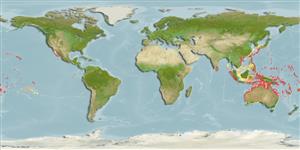Environment: milieu / climate zone / depth range / distribution range
Ecologia
marinhas associadas(os) a recifes; intervalo de profundidade 4 - 40 m (Ref. 90102), usually 27 - 30 m (Ref. 9710). Tropical
Western Pacific: southern Japan to the Great Barrier Reef, east to Pitcairn, west to Western Australia.
Tamanho / Peso / Idade
Maturity: Lm ? range ? - ? cm
Max length : 15.0 cm TL macho/indeterminado; (Ref. 48636)
Espinhos dorsais (total) : 5; Raios dorsais (total) : 21; Espinhos anais: 1; Raios anais : 16 - 17. Recognized by the double lines of dashes over the back (Ref. 48636). Lower two-thirds of body whitish with 8 narrow red bars, each containing 2 dark spots (black or darker red), one at of bar and one at level of lower third of body. A small dark red to black spot on abdomen above base of pelvic fins. Spinous portion of dorsal fin cream with a broad oblique black bar (except posteriorly). Scales on opercle cycloid (Ref 42740).
Mainly occurs at moderate depth on open rubble reef flats, but occasionally more shallow on outer reef habitats (Ref. 48636). Usually on rubble or sand near coral reefs (Ref. 42740) solitary or forms small groups (Ref. 90102).
Ciclo de vida ou comportamento de acasalamento
Maturities | Reprodução | Spawnings | Egg(s) | Fecundities | Larvas
Randall, J.E., G.R. Allen and R.C. Steene, 1990. Fishes of the Great Barrier Reef and Coral Sea. University of Hawaii Press, Honolulu, Hawaii. 506 p. (Ref. 2334)
Status na Lista Vermelha da UICN (Ref. 130435)
Ameaça para os humanos
Harmless
Uso pelos humanos
Pescarias: sem interesse
Ferramentas
Relatórios especiais
Baixar XML
Fontes da internet
Estimates based on models
Preferred temperature (Ref.
123201): 24.2 - 28.5, mean 26.9 °C (based on 46 cells).
Índice de diversidade filogenética (Ref.
82804): PD
50 = 0.5000 [Uniqueness, from 0.5 = low to 2.0 = high].
Bayesian length-weight: a=0.00692 (0.00311 - 0.01538), b=3.06 (2.88 - 3.24), in cm total length, based on LWR estimates for this Genus-body shape (Ref.
93245).
Nível Trófico (Ref.
69278): 3.5 ±0.4 se; based on size and trophs of closest relatives
Resiliência (Ref.
120179): Elevada, tempo mínimo de duplicação da população menor que 15 meses (Preliminary K or Fecundity.).
Fishing Vulnerability (Ref.
59153): Low vulnerability (10 of 100).
Nutrients (Ref.
124155): Calcium = 110 [59, 172] mg/100g; Iron = 0.719 [0.451, 1.168] mg/100g; Protein = 18.1 [15.8, 20.0] %; Omega3 = 0.102 [0.062, 0.174] g/100g; Selenium = 29.9 [15.5, 58.9] μg/100g; VitaminA = 102 [36, 283] μg/100g; Zinc = 1.64 [1.12, 2.31] mg/100g (wet weight);
